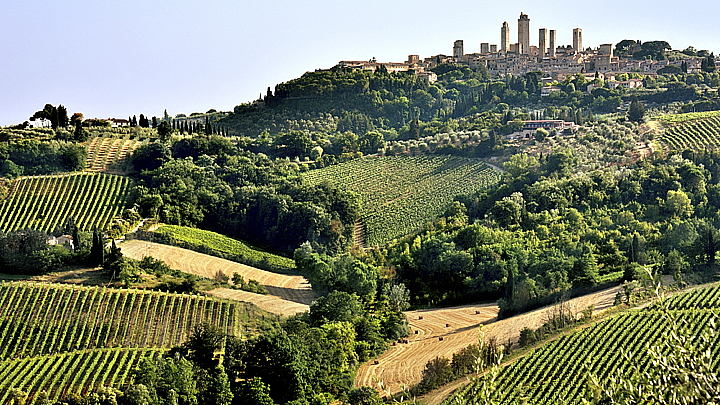The production of wine in Tuscany goes back to a time even before the Romans; the Etruscan peoples were exporting wine in amphorae over 2700 years ago, and Greek writers heralded the quality of the wines from the region. At this time the wines were predominantly white, and almost certainly sweet; after the fall of the Roman Empire, though, monasteries became centres of wine production, and red wine became increasingly important.
In the Middle Ages, Tuscany, and especially the rolling hills of Chianti, became a prize in the rivalry between the city-states of Sienna and Florence. In the 13th Century they decided to settle their respective claims with a horse race. When a rooster sang at dawn, a rider would set off from each city and ride towards the other; the point at which they met would mark the new borders of their respective territories. The Florentines chose a black rooster, and kept it in a sealed box; when it was released, it sang long before the dawn, and the Florentine rider set off early. At dawn, the white rooster of Sienna sang, and their rider set off, only to meet the rider from Florence 20km from the walls of his city. Thus, Florence gained control of the entire region of Tuscany, and the black rooster became the symbol of Chianti. Since 2013, it appears on every bottle of Chianti Classico DOCG wine.
The great red-grape of Tuscany is Sangiovese; with dozens of different clones producing wines which vary in style from the deep, powerful reds of Brunello di Montalcino to the delicate wines of appellations like Chianti Rufina in the north. From the 1940s onwards, some producers have planted French grape varieties, not permitted by the existing appellations, and created great vino di tavola (table-wines), the Super Tuscans – famous names like Sassicaia, Ornellaia and Tignanello, among others.
White wines of Tuscany are very popular within Italy, although since they amount for less than 20% of the region’s production they are often not easy to find on export-markets. Another famous Tuscan wine (although it may be produced throughout Italy) is Vin Santo. Usually (but not always) sweet, these wines will be made from late-harvest grapes which are dried in the sun before being pressed to extract the juice. In Tuscany they tend to be made from the Malvasia and Trebbiano di Toscana grape varieties, giving a sweet, nutty character with attractive aromatic complexity from the Malvasia.
If you are keen on discovering more Tuscan wines, Friarwood are hosting a Discovery Tasting dedicated to these stunning Italian wines. You can find more information on the Discovery Tasting here.
With thanks to Friarwood Wines for this article.


